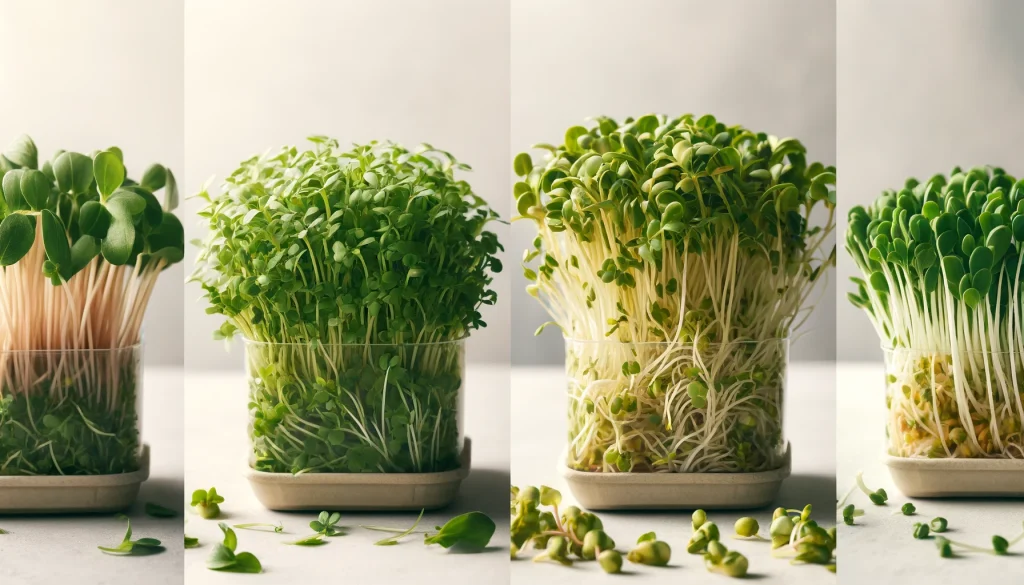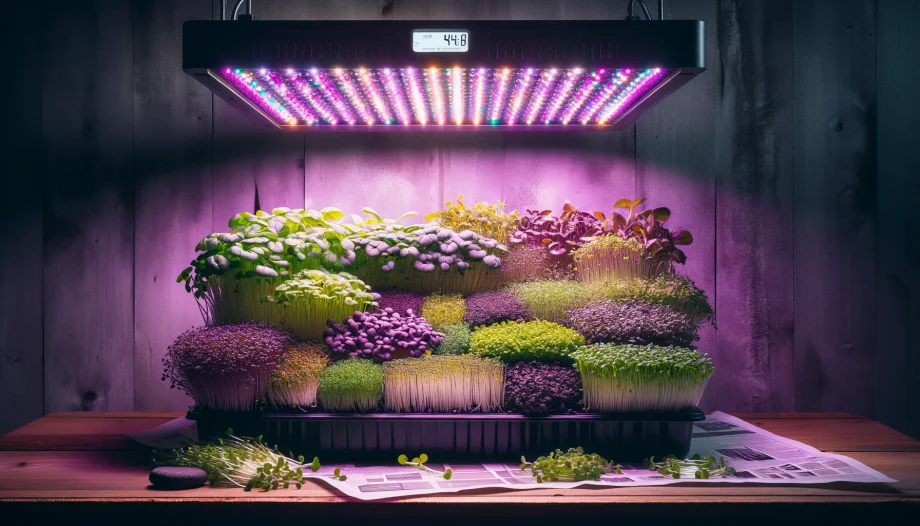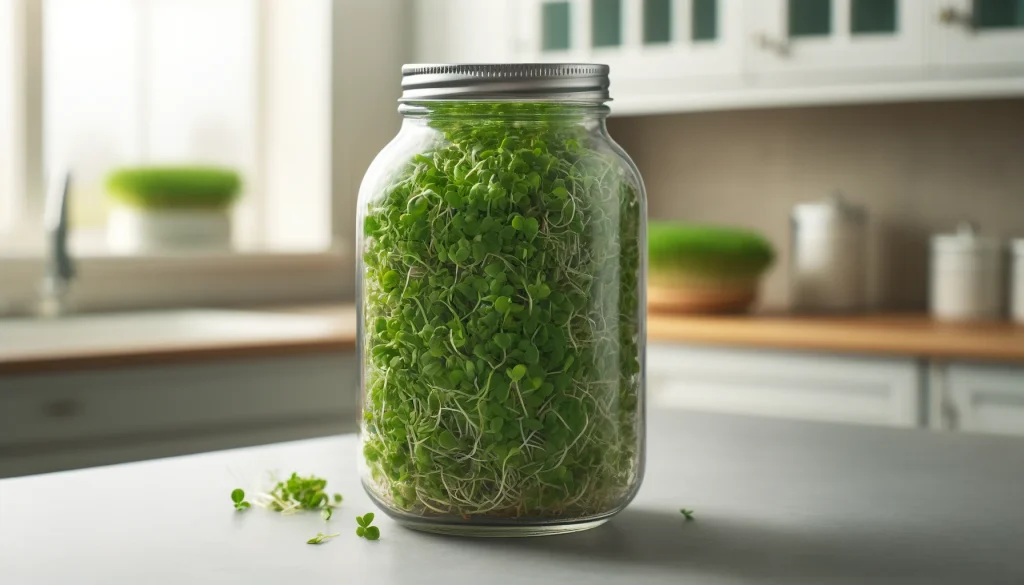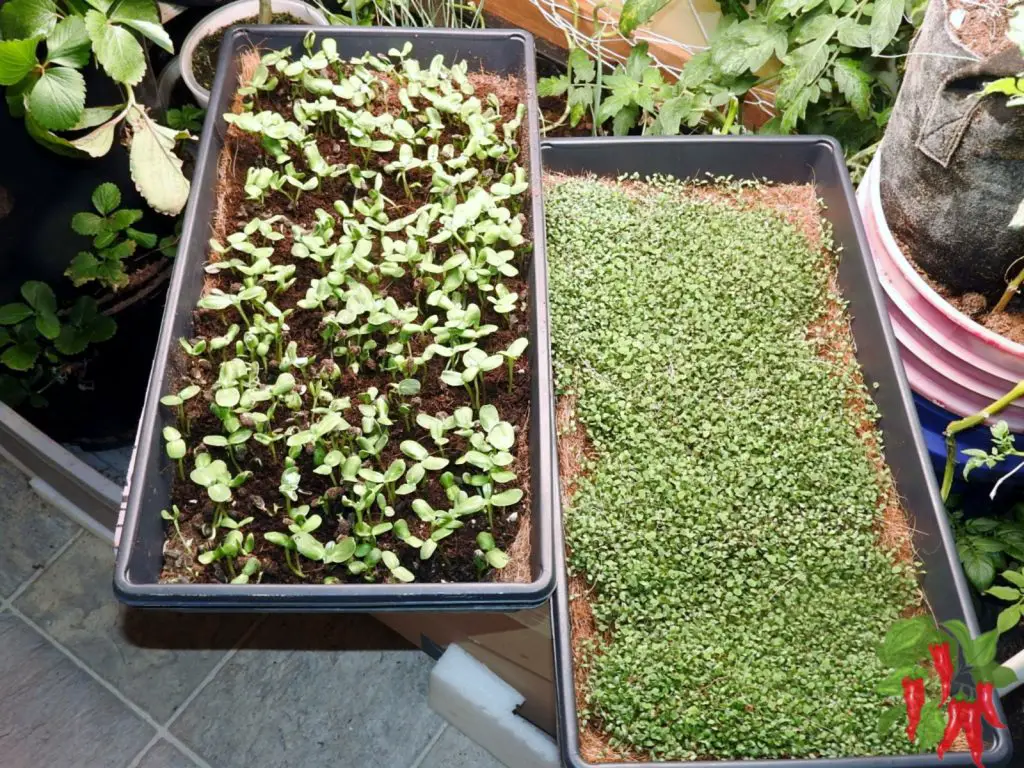This post may contain affiliate links. If you buy something from one of our links we may earn a commission. Thanks

Dive into the microgreens vs sprouts debate with our friendly guide! Discover the differences in nutrition, growth, and uses to decide which is best for your garden.
Microgreens vs Sprouts Key Takeaways:
- Microgreens and sprouts both offer unique nutritional and culinary benefits.
- Microgreens, grown in soil with sunlight, are leafy greens that are harvested after their first true leaves develop.
- Sprouts, grown in water without light, include the seed, root, and stem.
- Microgreens tend to have higher vitamin and mineral levels, while sprouts are rich in enzymes and easy to digest.
Diving Into the Greens: Microgreens vs. Sprouts Showdown
Ever felt like your meals are missing a little zing? Well, microgreens and sprouts might just be the secret ingredients you’re looking for!
These tiny powerhouses are not only bursting with nutrients but also pack a flavorful punch that can jazz up any dish.
But here’s the kicker – they’re not the same thing!
So, let’s embark on a tasty journey to uncover the differences between these two and find out which one’s the champion of your kitchen.
The Lowdown on Microgreens and Sprouts
- Microgreens and sprouts – they’re like the dynamic duo of the nutrition world, each with its own set of superpowers.
- Microgreens: These are the young’uns of the leafy green family, harvested right after their first true leaves pop up. They’re like the teenagers of the plant world, full of energy (and nutrients) and ready to add some pep to your meals.
- Sprouts: These are the babies of the bunch, grown in water, and are all about the seed, root, and stem. They’re like the infants of the greens world, tender and packed with enzymes that make them easy to digest.
Now, here’s where it gets interesting – microgreens are like the nutrient-packed heavyweights, with more vitamins and minerals than you can shake a stick at.
On the other hand, sprouts are the easy-to-digest champs, making them a great choice for keeping your tummy happy.
Ready to Add Some Green to Your Scene?
So, you’re probably wondering, “How do I add these green wonders to my dishes?” No worries, fellow foodie!
Whether you’re a green thumb in the garden or a culinary wizard in the kitchen, this guide’s got you covered.
We’ll dive into the nitty-gritty of microgreens and sprouts, from their nutritional benefits to their scrumptious uses in your favorite dishes.
Get ready to give your meals and health a green boost that’ll make your taste buds sing!
Discovering the Magic of Microgreens and Sprouts
In the journey toward healthier eating, microgreens and sprouts have taken the spotlight in kitchens everywhere.
These tiny wonders are more than just garnishes; they’re nutritional powerhouses that bring a burst of flavor and health to any dish.
While both microgreens and sprouts are celebrated for their rich nutrient content and culinary versatility, they each have their own unique traits that set them apart.
From the way they grow to the nutritional benefits they offer, understanding these differences is key to making the most of these vibrant greens in your diet.
Exploring the World of Microgreens and Sprouts
Our mission in this post is to delve into the fascinating differences and similarities between microgreens and sprouts.
We’ll take a closer look at their appearances, nutritional profiles, growth processes, and how they can be used in the kitchen.
Whether you’re thinking about growing these greens at home or just want to add some extra nutrition to your meals, this guide will equip you with the knowledge you need.
By the end of this journey, you’ll have a deeper appreciation for the unique qualities of microgreens and sprouts and how they can enhance your culinary creations and contribute to a healthier lifestyle.
So, let’s embark on this adventure together, exploring the colorful and nutritious world of microgreens and sprouts.
We’ll uncover the secrets of these tiny greens and help you discover which ones are the perfect fit for your culinary experiments and health goals.
What’s the Deal with Microgreens and Sprouts?
Alright, let’s get down to the nitty-gritty and chat about what we mean when we throw around terms like microgreens and sprouts.
You might’ve heard them used like they’re the same thing, but trust me, they’re as different as night and day, each with their own cool features and perks.
So, let’s clear the air and break down what’s what in the world of these tiny but mighty greens.
Microgreens are vegetable greens (not to be confused with sprouts or shoots) harvested just after the cotyledon leaves have developed with one set of true leaves. They are used as a visual, flavor and texture enhancement. Microgreens are used to add sweetness and spiciness to foods. Microgreens are smaller than “baby greens” because they are harvested soon after sprouting, rather than after the plant has matured to produce multiple leaves.
They provide garnishing for salads, soups, sandwiches, and plates. Some recipes use them as a garnish while others use them as a main ingredient.
Edible young greens are produced from various kinds of vegetables, herbs, or other plants. They range in size from 1 to 3 inches (2.5 to 7.6 cm), including the stem and leaves. The stem is cut just above the soil line during harvesting. Microgreens have fully developed cotyledon leaves and usually, one pair of small, partially developed true leaves. Wikipedia
Getting to Know Microgreens

So, What Are Microgreens Anyway? Imagine your favorite veggies, but miniaturized.
That’s what microgreens are! They’re like the baby versions of vegetables, about 1–3 inches tall, and they’re harvested just when they sprout their first true leaves.
These little guys are more than just cute; they’re nutrient-packed and have way more flavor and color than their grown-up versions or their sprout cousins.
It’s like they’re in their prime, bursting with all the good stuff.
Microgreens come in all sorts of colors, textures, and flavors, depending on what plant they come from.
You could get a sweet and mild taste from one and a spicy kick from another. They’re super versatile, so you can jazz up all kinds of dishes with them.
They’re usually grown in soil or something like it, and they need some good light to do their photosynthesis thing.
You’ve probably heard of or even tasted some popular types like arugula, radish, beet greens, broccoli, and kale microgreens.
What’s the Scoop on Sprouts?

Picture this: seeds that have just started to wake up and grow, with their tiny roots, stems, and baby leaves all ready to munch on.
That’s what sprouts are! They’re like the newborns of the plant world.
Here’s how it goes down: you soak the seeds in water to kickstart their growth. Give them a few days of soaking and rinsing, and voilà, you’ve got sprouts.
No need for soil or sunlight here, which is a big difference from microgreens and other young plants.
Sprouts are usually smaller than microgreens, and they’ve got this crunchy vibe going on with a hint of nuttiness.
You can sprout all sorts of seeds, like alfalfa, lentils, chickpeas, and mung beans.
Since they grow in the dark, sprouts don’t get all green from chlorophyll, so they’re rocking the white and yellow look.
But don’t let their pale color fool you – they’re packed with enzymes that make them super easy to digest.
You’ll find sprouts adding some crunch to salads, sandwiches, and all sorts of dishes.
In a Nutshell:
Alright, so now that we’ve got the lowdown on microgreens and sprouts, we can see how they each bring their own special something to the table.
They’re both nutritional champs and can really up the game of your meals with their fresh, healthy vibes.
So, whether you’re tossing them in a salad or sprinkling them on a sandwich, these greens are a top-notch pick for anyone wanting to add a little green goodness to their plate.
Appearance and Texture: A Feast for the Eyes and Palate
When it comes to food, looks and feel matter just as much as taste. That’s where microgreens and sprouts come in – they’re tiny but mighty when it comes to adding a visual and textural pop to your dishes.
Microgreens: A Colorful and Textured Delight
Microgreens are like the show-offs of the plant world, strutting their stuff with an array of vibrant colors, textures, and shapes.
From the deep reds and purples to the bright greens and yellows, they can make any dish look like a masterpiece.
The textures are all over the map too – from tender and delicate to a bit crunchy, adding an interesting twist to your meals.
And don’t even get me started on the shapes! Whether it’s the round leaves of basil or the jagged edges of kale, microgreens bring variety to the table.
But the real stars of the show are the true leaves. These are the first leaves that pop up after the baby leaves (cotyledons), and they’re packed with chlorophyll, which means more flavor and nutrients.
When you see these true leaves, you know the microgreens are at their prime for eating and looking pretty on your plate.
Sprouts: Simple Yet Satisfying
Sprouts are more on the simple side, but they’ve got their own charm. They’re made up of a sprouted seed, a little stem, and some basic leaves (also cotyledons).
They’re usually tender and moist, with a bit of crunch depending on the seed.
Since they grow in the dark, sprouts don’t bother with chlorophyll, so they’re rocking a white and yellow look.
But don’t be fooled – they’re still packed with good stuff for your body, even if they’re not as colorful as microgreens.
In a Nutshell:
To wrap it up, microgreens and sprouts might both be small, but they bring big personality to your dishes with their unique looks and feels.
Whether you’re going for the colorful and varied vibes of microgreens or the simple and crunchy appeal of sprouts, they’re sure to add some pizzazz to your culinary creations.
Nutritional Content Comparison: What’s the Scoop?
When you’re trying to pick between microgreens and sprouts, it’s all about what’s on the inside that counts.
Both of these green goodies are health heroes, but they’ve got different nutritional superpowers that might sway your choice depending on what your body’s craving.
Microgreens: The Nutrient Powerhouses
Microgreens are like the nutrient-packed tiny titans of the plant world. They’re loaded with vitamins, minerals, and antioxidants, all squished into a little bit of plant.
This nutrient bonanza happens because they’re picked when they’re still in their youthful, nutrient-rich stage.
Research has shown that these little guys can have more vitamins C, E, K, and beta-carotene than their grown-up plant versions.
When it comes to microgreens vs sprouts, microgreens often pack a more concentrated nutrient punch.
Take broccoli microgreens, for example. They’ve got more vitamins and antioxidants than broccoli sprouts.
This is a big deal because these nutrients are like the body’s superheroes, fighting off diseases and keeping you in tip-top shape.
And let’s not forget about sulforaphane, a compound with some serious anticancer creds. It’s in both microgreens and sprouts, but the levels can vary.
Sprouts: The Digestible Delights
Sprouts are no slouches in the nutrition department either. They’re brimming with protein, fiber, vitamins, and minerals.
The cool thing about sprouts is that when they’re germinating, they activate enzymes that make their nutrients easier for your body to soak up.
So, even though sprouts might not have as high levels of certain nutrients as microgreens, your body might be able to use what they do have more effectively.
Broccoli sprouts, for example, are famous for their sulforaphane content, which is great for fighting off inflammation and cancer.
But when you’re choosing between sprouts and microgreens, it’s good to look at the whole nutritional picture.
In a Nutshell:
Both microgreens and sprouts are nutritional champs in their own right. Microgreens are the go-to for a concentrated hit of vitamins and antioxidants, while sprouts shine with their easily digestible nutrients and sulforaphane boost.
Knowing the ins and outs of their nutritional content can help you make the best choice for adding some green power to your meals and keeping your health game strong.
Growth Process and Cultivation: Green Thumbs Up!

Now, let’s talk about how these green goodies grow. Knowing their growth process and cultivation can help you decide if you want to try growing them at home or just stick to picking them up at the store.
Microgreens: A Little Dirt, A Little Light
Microgreens are like the divas of the plant world – they need their soil (or a soil substitute) and their spotlight to strut their stuff. Here’s the lowdown on growing microgreens:
- Soil or Substitute: You can grow microgreens in soil, coconut coir, or even hydroponic setups. The key is to have something that holds moisture but also drains well. I like to use coco coir for my microgreens.
- Light it Up: Microgreens need light to photosynthesize and develop their colors and nutrients. You can use natural sunlight or get fancy with some artificial grow lights.
- Quick Turnaround: One of the best things about microgreens is that they’re ready to harvest in about 7 to 21 days, depending on what you’re growing. Talk about fast food!
Growing microgreens is like having a mini garden in your kitchen. Just sprinkle the seeds on your growing medium, keep them moist, and give them some light.
In no time, you’ll have a fresh supply of greens to jazz up your meals.
Growing Sprouts: Just Add Water
Sprouts are the low-maintenance buddies in the plant world. They’re all about keeping it simple – no soil, no light, just water. Here’s the scoop on sprouting:
- Soak and Rinse: Start by soaking your seeds in water to wake them up. Then, rinse them a couple of times a day to keep them moist and happy.
- No Soil, No Problem: Since sprouts grow in water, you don’t need any soil. You can use a jar, a sprouting bag, or a tray – whatever floats your boat.
- Quick Sprouts: Sprouts are ready to eat in just 2 to 7 days. That’s even faster than microgreens!
Sprouting is a breeze, and it’s a great way to get some fresh, crunchy greens into your diet without any fuss.
In contrast to microgreens, sprouts are grown without soil and require minimal light, making them an easy DIY project for growing sprouts at home.
You can also buy a sprouting jar kit.
In a Nutshell:
Whether you’re into the slightly more involved process of growing microgreens or the super-simple sprouting method, both options offer a rewarding way to bring some fresh greens into your life.
So why not give it a go and see your culinary creations come to life with homegrown goodness?
Culinary Uses and Flavor Profiles: Spice Up Your Dishes
When it comes to cooking, microgreens and sprouts are like the secret sauce that can take your dishes from meh to wow.
They’re not just about the health benefits; they bring some serious flavor and texture game to the table.
Microgreens: The Flavor Boosters
Microgreens are like the little flavor bombs in the kitchen. They pack a punch with their strong flavors and can add a whole new dimension to your dishes. Here’s how you can use them:
- Garnishes: Sprinkle some microgreens on top of your soups, salads, or main dishes, and watch them transform into a colorful and tasty masterpiece.
- Salads: Mix up a salad with different microgreens for a nutrient-packed and flavor-filled bowl of goodness.
- Sandwiches and Wraps: Level up your sandwiches and wraps by adding a layer of microgreens for an extra crunch and a burst of flavor.
- Smoothies and Juices: Toss some microgreens into your smoothies or juices for a sneaky way to get more vitamins and minerals without messing with the taste.
With microgreens, you can get creative and add a gourmet touch to your everyday meals, making them not only healthier but also more delicious.
Sprouts: The Crunchy Companions
Sprouts might be small, but they’re mighty when it comes to adding a crunchy texture and a nutty flavor to your dishes.
Here’s how you can incorporate them into your meals:
- Salads: Throw some sprouts into your salad for a fresh and crispy element that pairs well with all sorts of dressings.
- Sandwiches and Wraps: Add a handful of sprouts to your sandwiches or wraps for a satisfying crunch and a subtle earthy flavor.
- Toppings: Sprinkle sprouts on top of your soups, stir-fries, or bowls to add a nutritious and crunchy finish.
- Smoothies and Juices: Just like microgreens, you can blend some sprouts into your smoothies or juices for an extra boost of nutrients.
While sprouts are great raw, cooking them can be a good idea, especially for those with sensitive tummies.
A quick steam or sauté can kill any bad bacteria without taking away from their taste or nutritional value.
In a Nutshell:
To wrap it up, both microgreens and sprouts are culinary superheroes that can elevate your dishes with their unique flavors and textures.
Whether you’re adding a pop of color and taste with microgreens or a crunchy kick with sprouts, these greens are sure to bring some excitement to your cooking adventures.
Safety Considerations: Play It Safe with Your Greens
We all love the health kick we get from microgreens and sprouts, but it’s super important to keep safety in mind to make sure we’re getting all the goodness without any risks.
Microgreens Safety: Keeping It Clean
Microgreens are usually safe to chow down on, especially if they’re grown and handled the right way.
But like any fresh produce, they can pick up some nasty germs if things aren’t kept clean. Here are some tips to keep your microgreens in tip-top shape:
- Growing Environment: Make sure your soil or growing medium and water are clean to avoid any bad bacteria hitching a ride on your microgreens.
- Hygiene: Wash your hands well before handling microgreens, and use clean tools and containers for harvesting and storing them.
- Storage: Give your microgreens a gentle rinse under running water to get rid of any dirt, then dry them and pop them in a clean, airtight container in the fridge to keep them fresh and reduce the risk of bacteria.
- Purchasing: When buying microgreens, look for signs that they’re fresh, like bright colors and crisp leaves. Steer clear of any that look slimy or wilted.
Sprouts Safety: Better Safe Than Sorry
Sprouts are a bit more prone to bacterial contamination, like E. coli and Salmonella, because they love warm, moist conditions. Here’s how to enjoy sprouts safely:
- Purchasing: Get your sprouts from places you trust, and make sure they’re kept cool and look fresh. Avoid any sprouts that smell off or look slimy.
- Rinsing: While rinsing can help wash away some germs, it won’t get rid of all of them. So, rinsing is good, but it’s not a foolproof safety measure.
- Cooking: The best way to kill any bacteria on sprouts is to cook them well. A quick steam until they’re crisp-tender is a good way to go.
- Special Populations: If you’re pregnant, have a weak immune system, are elderly, or are feeding young kids, it’s a good idea to skip raw sprouts altogether. If you do eat them, make sure they’re cooked.
In a Nutshell:
To wrap things up, both microgreens and sprouts are awesome for your health, but it’s important to handle them safely to avoid any risks.
Keep things clean, store them right, and when in doubt, cook those sprouts to keep things safe and sound.
Microgreens vs Sprouts FAQs:
Hey there, green thumbs and foodies! Ever find yourself pondering the wonders of microgreens and sprouts? You’re not alone!
These tiny greens are big on nutrition and flavor, but they often leave folks scratching their heads with questions.
We’re here to tackle some common queries and help you navigate the leafy world of microgreens and sprouts. Let’s dive in!
Q: Which is better: microgreens or sprouts?
A: Ah, the age-old question! It’s like asking whether chocolate or vanilla is better – it all comes down to what tickles your taste buds and fits your health goals.
Microgreens are the show-offs with their vibrant colors and intense flavors, packed with vitamins and antioxidants.
Sprouts, on the other hand, are the easy-going type, known for their crunch and being kind to your tummy with their enzyme content.
So, take your pick based on what you’re craving and what your body needs!
Q: Are microgreens safe during pregnancy?
A: Yep, microgreens can be a fantastic addition to your diet when you’re expecting, giving you and your little one a boost of essential nutrients.
Just make sure they’re grown and handled with care to avoid any unwanted germs.
And hey, it’s always a good idea to have a chat with your healthcare provider before making any big changes to your diet.
Q: Can sprouts be eaten raw?
A: You betcha! Sprouts are often munched on raw to keep all those nutrients intact.
But if you’re pregnant, have a weaker immune system, or are feeding young kids or seniors, you might want to cook those sprouts to play it safe and kill off any potential bad bacteria.
Q: How do you grow microgreens at home?
A: Growing microgreens at home is like having your own mini garden on your windowsill!
Grab a shallow tray, some good soil or a soilless medium, sprinkle those microgreen seeds, and make sure they get plenty of light.
Keep the soil moist, and in about a week or three, you’ll have your very own homegrown microgreens ready for harvest!
Q: What are the best sprouts for beginners to grow?
A: If you’re just dipping your toes into the sprouting world, start with the easy-peasy ones like mung beans, alfalfa, and lentil sprouts.
All you need is a jar, some water, and a bit of patience. In a few days, you’ll have fresh sprouts ready to add some crunch to your meals!
Q: Do microgreens and sprouts need sunlight to grow?
A: Microgreens are like little sunbathers – they need sunlight or artificial light to grow and get all colorful and flavorful.
Sprouts, on the other hand, are more like night owls. They don’t need sunlight and are happy to grow in a darker, moist environment, which is why they’re usually white or yellow.
Microgreens vs Sprouts Conclusion: Wrapping Up the Green Debate
Alright, folks, we’ve had a good look at the world of microgreens and sprouts, and it’s been quite the green journey!
We’ve dug into what makes each of these leafy wonders unique, from how they look and feel to the good stuff they pack in terms of nutrients, how they grow, and the tasty ways you can use them in your cooking.
Key Differences and Similarities: A Quick Recap
Let’s do a quick recap: Microgreens are like the teenagers of the veggie world, all colorful and full of flavor, needing some soil (or something like it) and light to grow. They take about 7 to 21 days to be ready for your plate.
Sprouts, on the other hand, are the infants, growing in just water, no light needed, and they’re ready to munch on in just 2 to 7 days.
While microgreens are all about adding a pop of color and a bunch of nutrients to your dishes, sprouts bring that satisfying crunch and are super easy to digest thanks to their enzyme content.
Personal Preference, Culinary Needs, and Safety: What’s Your Green?
When it comes down to picking your green team, think about what you like taste-wise, what you need nutrition-wise, and how you want to use them in your cooking.
And hey, don’t forget about safety, especially if you’re munching on sprouts – a little cooking might be in order to keep things on the safe side.
Growing Your Own: Green Thumbs Unite!
If you’re feeling adventurous, why not try growing your own microgreens and sprouts?
It’s a fun way to get the freshest greens around and feel a bit like a gardening champ.
Plus, you get to control how they’re grown, so you know they’re top-notch and clean.
Final Thoughts: Go Green, Go Tasty
In the end, whether you’re team microgreen or team sprout, adding these little green dynamos to your diet is a win-win for taste and health.
So, why not give them a shot and see how they can brighten up your meals and boost your well-being?
With a dash of care and a sprinkle of love, you can enjoy the awesome benefits of these mighty greens right from your kitchen or even your garden.
Learn how to grow microgreens
Learn more in our Indoor Apartment Gardening: 15 Point Comprehensive Guide
Visit my Amazon Influencer Page for videos and gardening products Grow Your Own Garden








